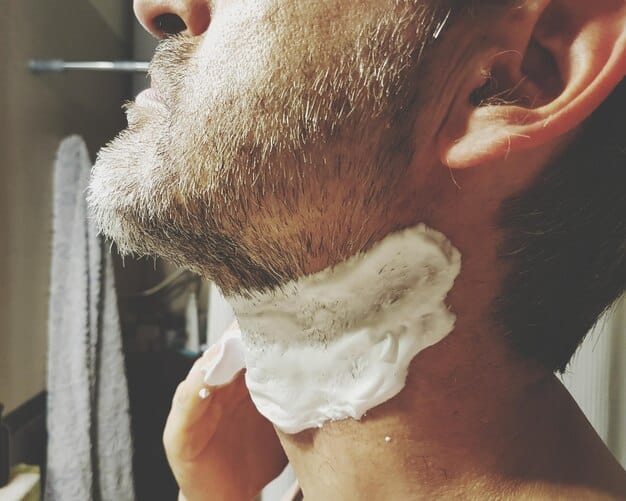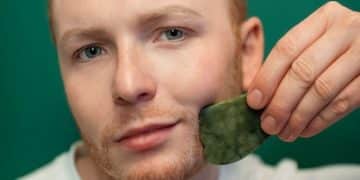The Ultimate Guide to Men’s Skincare Routines: Age-Specific Tips

The Ultimate Guide to Men’s Skincare Routines for Every Age Group provides tailored advice, product recommendations, and essential tips to help men maintain healthy, youthful skin throughout their lives, addressing specific concerns from acne in adolescence to wrinkles in older age.
Welcome to The Ultimate Guide to Men’s Skincare Routines for Every Age Group. Taking care of your skin shouldn’t be complicated; it should be a straightforward practice that adjusts as you age.
Understanding Men’s Skincare Needs
Men’s skin differs from women’s in terms of thickness, texture, and oil production. Understanding these differences is crucial to crafting an effective skincare routine tailored to meet specific needs at different stages of life.
The Basics of Men’s Skin
Men’s skin is generally thicker and produces more sebum (oil) than women’s skin due to higher testosterone levels. This can lead to different skin concerns, such as larger pores and a higher susceptibility to acne during adolescence and young adulthood. Over time, these characteristics influence how skincare products and routines should be adapted.
- Thicker Skin: Due to higher collagen density, men’s skin typically appears more resilient.
- Higher Sebum Production: More oil production necessitates different cleansing and moisturizing approaches.
- Shaving: A regular shaving routine introduces unique challenges, like irritation and ingrown hairs.

Recognizing these fundamental differences allows men to select products and practices that effectively address their skin type and stage of life. Whether it’s managing oily skin during teenage years or combating dryness and wrinkles later in life, a tailored approach is key. Understanding the evolving nature of men’s skin is the first step in cultivating a customized skincare routine.
Teenage Years: Tackling Acne and Oil
Teenage years often bring about a surge in oil production and the onset of acne. Establishing a consistent skincare routine during this time is crucial for managing these issues and setting the stage for healthy skin in the future.
Effective Cleansing
Cleansing is the cornerstone of any skincare routine, especially for teenagers dealing with oily skin and acne. Proper cleansing removes excess oil, dirt, and impurities that clog pores and lead to breakouts.
Using a gentle cleanser twice a day helps maintain a clean surface without stripping the skin of its natural oils. Over-cleansing can actually trigger increased oil production, exacerbating the problem. Look for cleansers that contain salicylic acid or benzoyl peroxide, which are effective at breaking down oil and fighting acne-causing bacteria.
Exfoliating 1-2 times a week can further unclog pores and remove dead skin cells, preventing future breakouts. Physical exfoliants like scrubs should be used gently to avoid irritation, while chemical exfoliants like AHAs or BHAs offer a deeper cleanse.
Lightweight Moisturizing
Even oily skin needs hydration. Skipping moisturizer can lead to dehydration, causing the skin to produce even more oil in an attempt to compensate. A lightweight, oil-free moisturizer will provide the necessary hydration without clogging pores.
- Choose Oil-Free Products: Avoid heavy creams that can clog pores.
- Look for Non-Comedogenic Labels: These products are specially formulated not to cause breakouts.
- Apply After Cleansing: Lock in moisture while the skin is still damp.
Consistency is crucial during these years. By making skincare a daily habit, teenagers can effectively manage acne and oil production, setting the foundation for healthy, clear skin in the long run. Remember, simple routines often yield the best results when upheld with dedication.
The 20s: Prevention and Protection
Entering your 20s means understanding the importance of prevention. Focus on establishing good habits and protecting your skin from environmental damage to ensure a healthy complexion as you age.
Sun Protection
Sunscreen is non-negotiable. Prolonged sun exposure is one of the primary causes of premature aging, leading to wrinkles, sunspots, and an increased risk of skin cancer. Incorporating sunscreen into your daily routine is a simple yet effective way to protect your skin.
Choose a broad-spectrum sunscreen with an SPF of 30 or higher, and apply it liberally 15-20 minutes before sun exposure. Reapply every two hours, especially if you’re swimming or sweating. Make it a habit to apply sunscreen every morning, even on cloudy days, as UV rays can penetrate through cloud cover.
Consider using a moisturizer that already contains SPF to streamline your routine. This ensures that your skin stays hydrated and protected. Remember, consistency is key when it comes to sun protection. Make it a daily ritual to safeguard your skin’s health and appearance.
Antioxidants
Antioxidants play a vital role in preventing skin damage from free radicals, which are unstable molecules that can accelerate aging. Incorporating antioxidants into your skincare routine can help neutralize these free radicals and protect your skin’s overall health and vibrancy.
Vitamin C is a powerful antioxidant that brightens the skin, promotes collagen production, and protects against sun damage. Apply a Vitamin C serum in the morning before your sunscreen to maximize its protective effects. Other effective antioxidants include Vitamin E, retinol, and niacinamide, each offering unique benefits for the skin.
Choosing products that suit your particular skin type is essential for achieving optimal results. Whether you have oily, dry, or sensitive skin, there are antioxidant-rich formulas available that cater to your specific needs. Integrating these powerful ingredients into your daily skincare routine can create a shield against environmental damage and support long-term skin health.
The 30s: Addressing Fine Lines and Dark Spots
As you enter your 30s, new concerns such as fine lines and dark spots may start to appear. Addressing these issues early can help maintain a youthful and healthy complexion. Adjustments in your skincare routine are vital at this stage.
Retinoids
Retinoids are vitamin A derivatives that increase cell turnover, stimulate collagen production, and reduce the appearance of fine lines and wrinkles. They’re a powerhouse ingredient for anti-aging and overall skin rejuvenation. Incorporating retinoids into your skincare routine can significantly improve your skin’s texture and tone.
Start with a low concentration retinoid, such as retinol, and gradually increase the frequency of use as your skin becomes more tolerant. Apply it in the evening, as retinoids can make your skin more sensitive to the sun. Always follow up with a moisturizer to combat potential dryness or irritation.
For those with sensitive skin, consider buffering the retinoid by applying it after your moisturizer or using a milder form, such as retinyl palmitate. Consistency is key when using retinoids; with continued use, you’ll start to notice a visible improvement in your skin’s appearance.
Exfoliation
Regular exfoliation helps remove dead skin cells, revealing brighter, smoother skin underneath. As you age, cell turnover slows down, making exfoliation even more important for maintaining a youthful glow and reducing the appearance of dark spots.
Chemical exfoliants, such as AHAs (alpha-hydroxy acids) and BHAs (beta-hydroxy acids), are effective in dissolving the bonds between dead skin cells. Glycolic acid and lactic acid are popular AHA choices, while salicylic acid is a great option for those with oily or acne-prone skin. Physical exfoliants, like scrubs and cleansing brushes, can also be used gently to remove dead skin cells.
- AHAs: Ideal for dry and sun-damaged skin, AHAs exfoliate the skin’s surface and promote collagen production.
- BHAs: Best for oily and acne-prone skin, BHAs penetrate pores to dissolve oil and dead skin cells.
- Frequency: Exfoliate 1-3 times per week, depending on your skin’s tolerance and the type of exfoliant used.

Proper exfoliation can make a significant difference in how skincare products are absorbed and how radiant your skin appears. Combine exfoliation with retinoids and sun protection for a comprehensive approach to maintaining healthy, youthful skin in your 30s. Remember to always follow up with a moisturizer and sunscreen after exfoliating.
The 40s and Beyond: Hydration and Repair
In your 40s and beyond, the skin becomes drier and less elastic. Focus on products that provide deep hydration and support skin repair to combat signs of aging. Tailored skincare routines become even more crucial as you age.
Hydration
As you age, your skin loses its ability to retain moisture, making hydration a critical element of your skincare routine. Dry skin can accentuate wrinkles and fine lines, so incorporating hydrating products can significantly improve your skin’s appearance. Look for products that contain hyaluronic acid, glycerin, or ceramides, all of which help draw moisture into the skin.
Integrate a hydrating serum into your daily routine, applying it after cleansing and before moisturizing. Choose a rich, emollient moisturizer that creates a protective barrier to lock in moisture. Consider adding a hydrating mask to your weekly routine for an extra boost of hydration. These masks provide a concentrated dose of moisture that revitalizes the skin.
Don’t forget the importance of internal hydration. Drinking plenty of water throughout the day helps keep your skin hydrated from the inside out. Pair this with a topical hydrating routine for optimal results.
Rich Moisturizers
Rich moisturizers are essential for combating dryness and supporting skin elasticity as you age. Look for products containing shea butter, natural oils, and antioxidants, which help nourish and protect your skin. These ingredients work together to hydrate the skin, reduce the appearance of wrinkles, and create a smoother, more supple complexion.
Apply a rich moisturizer twice a day, in the morning and evening, to maintain optimal hydration levels. Pay special attention to areas that tend to be drier, such as the forehead, cheeks, and neck. Consider using an overnight mask with hydrating ingredients to deeply moisturize the skin while you sleep.
Always choose products that cater to your skin type. Even mature skin can be oily or prone to breakouts, so select non-comedogenic formulas that hydrate without clogging pores. A well-chosen rich moisturizer forms the cornerstone of a skincare routine aimed at maintaining a youthful and healthy appearance in the long run.
Professional Treatments
Consider consulting with a dermatologist or aesthetician for professional treatments that can complement your at-home skincare routine. These treatments can address specific concerns like deep wrinkles, sun damage, and uneven skin texture.
Laser Resurfacing
Laser resurfacing involves using laser technology to remove layers of damaged skin, stimulating collagen production and improving skin texture. It’s an effective option for reducing the appearance of wrinkles, scars, and sunspots. There are different types of laser resurfacing, including ablative and non-ablative lasers, each offering varying levels of intensity and recovery time.
Ablative lasers remove the outer layer of skin, providing more dramatic results but requiring a longer recovery period. Non-ablative lasers heat the underlying skin without removing the surface, resulting in less downtime but more subtle improvements. Consult with a qualified professional to determine which type of laser treatment is best suited for your skin type and concerns.
After laser resurfacing, it’s crucial to follow a strict skincare routine to protect the skin and promote healing. This typically includes using gentle cleansers, moisturizers, and sunscreen. With proper care, laser resurfacing can significantly rejuvenate your skin and restore a more youthful appearance.
Chemical Peels
Chemical peels involve applying a chemical solution to the skin to exfoliate the outer layers, revealing smoother, brighter skin underneath. They’re effective for treating fine lines, wrinkles, acne, and hyperpigmentation. The strength of the peel determines the depth of exfoliation and the expected results. Superficial peels offer minimal downtime, while deeper peels provide more dramatic improvements but require a longer recovery period.
- Superficial Peels: Gentle peels that exfoliate the top layer of skin, ideal for addressing mild acne and uneven skin tone.
- Medium Peels: Penetrate deeper into the skin, targeting wrinkles and sun damage.
- Deep Peels: Provide significant improvements in skin texture and tone but require a longer recovery period and should be performed by an experienced professional.
After a chemical peel, it’s essential to protect the skin from sun exposure and follow your dermatologist’s instructions. This may include using gentle skincare products, applying sunscreen, and avoiding harsh exfoliants. Chemical peels can be a valuable addition to your skincare routine, providing noticeable improvements in skin health and appearance.
| Key Point | Brief Description |
|---|---|
| 🧼 Cleansing | Cleaning your face twice a day helps to remove excess dirt and oil. |
| ☀️ Sunscreen | Daily sunscreen application protects skin from aging and damage. |
| 💧 Moisturizing | Keeps skin hydrated and balanced, preventing dryness or over-oiliness. |
| ✨ Retinoids | Help reduce fine lines and wrinkles, improving skin’s overall texture. |
FAQ
▼
Skincare is crucial for men to maintain healthy skin, prevent aging, and address specific concerns like acne, dryness, or sun damage. Regular skincare also improves appearance and boosts confidence.
▼
Men should exfoliate their skin 1-3 times per week, depending on their skin type and the product used. Oily or acne-prone skin may benefit from more frequent exfoliation.
▼
The best sunscreen for men is a broad-spectrum sunscreen with an SPF of 30 or higher. It should be applied daily, even on cloudy days, to protect against UVA and UVB rays.
▼
Yes, shaving can cause irritation and ingrown hairs. Using a sharp razor, shaving in the direction of hair growth, and applying a soothing aftershave can help minimize these issues.
▼
Retinoids are vitamin A derivatives that increase cell turnover, stimulate collagen production, and reduce fine lines and wrinkles. They improve skin texture and tone and are best applied at night.
Conclusion
Ultimately, establishing a consistent and age-appropriate skincare routine is a worthwhile investment in your overall well-being. By understanding your skin’s unique needs at each stage of life and incorporating the right products and practices, you can achieve a healthy, confident complexion that reflects your best self.





